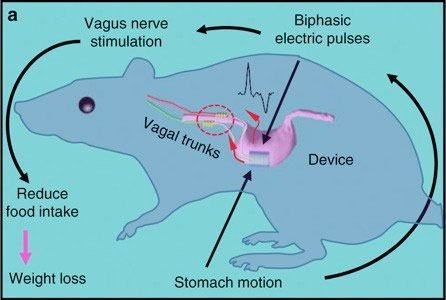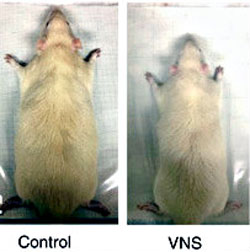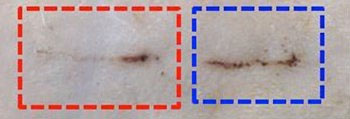| Jan 17, 2019 | |
Nanogenerators turn body motion Into weight control and wound-healing therapies(Nanowerk News) Although electrical stimulation has therapeutic potential for various disorders and conditions, ungainly power sources have hampered practical applications. Now bioengineers have developed implantable and wearable nanogenerators from special materials that create electrical pulses when compressed by body motions. The pulses controlled weight gain and enhanced healing of skin wounds in rat models. |
|
| The work was performed by a research team led by Xudong Wang, Ph.D., Professor of Material Sciences and Engineering, College of Engineering, University of Wisconsin-Madison, and supported by the National Institute of Biomedical Imaging and Bioengineering (NIBIB). | |
| The researchers used what are known as piezoelectric and dielectric materials, including ceramics and crystals, which have a special property of creating an electrical charge in response to mechanical stress. | |
 |
|
| Stomach motion from eating causes the attached nanogenerator to produce electrical pulses. When eating starts, the electrical pulses stimulate the vagus nerve, which tells the brain that the stomach is full (when it is not) and the animal stops eating. (Image: Xudong Wang, University of Wisconsin-Madison) | |
| “Wang and colleagues have engineered solutions to a number of technical hurdles to create piezoelectric and dielectric materials that are compatible with body tissues and can generate a reliable, self-sufficient power supply. Their meticulous work has enabled a simple and elegant technology that offers the possibility of developing electrical stimulation therapies for a number of major diseases that currently lack adequate treatments,” explained David Rampulla, Ph.D., director of the Program in Biomaterials and Biomolecular Constructs at NIBIB. | |
Shedding weight by curbing appetite |
|
| Worldwide, more than 700 million people -- over 100 million of them children -- are obese, causing health problems such as cardiovascular disease, diabetes, kidney disease, and certain cancers. In 2015 approximately four million people died of obesity-related causes. | |
| To address this crisis, Wang and his colleagues developed a vagal nerve stimulator (VNS) that dramatically improves appetite suppression through electrical stimulation of the vagus nerve. The approach is a promising one that has previously not proven practical because patients must carry bulky battery packs that require proper programming, and frequent recharging. | |
| The VNS consists of a small patch, about the size of a fingernail, which carries tiny devices called nanogenerators. Minimally invasive surgery was used to attach the VNS to the stomachs of rats. The rat’s stomach movements resulted in the delivery of gentle electrical pulses to the vagus nerve, which links the brain to the stomach. With the VNS, when the stomach moved in response to eating, the electric signal told the brain that the stomach was full, even if only a small amount of food was consumed. | |
| The device curbed the rat’s appetite and reduced body weight by a remarkable 40 percent. “The stimulation is a natural response to regulate food intake, so there are no unwanted side effects,” explained Wang. When the device was removed the rats resumed their normal eating patterns and their weight returned to pre-treatment levels. | |
 |
|
| The rat with the vagal nerve stimulating (VNS) device weighed 40 percent less than the control rat after 100 days. (Image: Xudong Wang, University of Wisconsin-Madison) | |
| “Given the simplicity and effectiveness of the system, coupled with the fact that the effect is reversible and carries no side-effects, we are now planning testing in larger animals with the hope of eventually moving into human trials,” said Wang. | |
Accelerating wound healing |
|
| In another NIBIB-funded study in a rat experimental model, the researchers used their nanogenerator technology to determine whether electrical stimulation would accelerate healing of wounds on the skin surface. | |
| For this experiment, a band of nanogenerators was placed around the rat’s chest, where the expansion from breathing created a mild electric field. Small electrodes in a bandage-like device were placed over skin wounds on the rat’s back, where they directed the electric field to cover the wound area. | |
| The technique reduced healing times to just three days compared with nearly two weeks for the normal healing process. | |
| Similar to the case with appetite suppression, it was known that electricity could enhance wound healing, but the devices that had been developed were large and impractical. The nanogenerator-powered bandage is completely non-invasive and produced a mild electric field that is similar to electrical activity detected in the normal wound-healing process. | |
| The researchers observed electrical activation of normal cellular healing processes that included the movement of healthy skin fibroblasts into the wound, accompanied by the release of biochemical factors that promote the growth of the fibroblasts and other cell types that expand to repair the wound space. | |
 |
|
| Red box left side is healed region following three days with dressing electrodes covering wound with electricity turned on. Dark region had no dressing covering the wound. Blue box shows unhealed area where dressing electrodes covered wound, but the electric current was turned off. (Image: Xudong Wang, University of Wisconsin-Madison) | |
| “The dramatic decrease in healing time was surprising,” said Wang, “We now plan to test the device on pigs because their skin is very similar to humans.” | |
| The team believes the simplicity of the electric bandage will help move the technology to human trials quickly. In addition, Wang explained that the fabrication of the device is very inexpensive and a product for human use would cost about the same as a normal bandage. | |
| The experiments on appetite suppression were reported in Nature Communications ("Effective weight control via an implanted self-powered vagus nerve stimulation device"). The wound-healing studies were reported in ACS Nano ("Effective Wound Healing Enabled by Discrete Alternative Electric Fields from Wearable Nanogenerators"). |
| Source: National Institute of Biomedical Imaging and Bioengineering | |
|
Subscribe to a free copy of one of our daily Nanowerk Newsletter Email Digests with a compilation of all of the day's news. |
